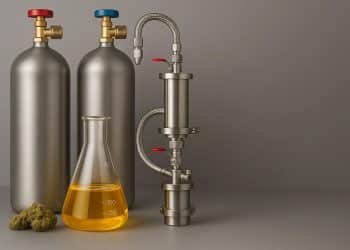Oh no, not I, I will survive
Oh, as long as I know how to love, I know I’ll stay alive
I’ve got all my life to live
And I’ve got all my love to give and I’ll survive
I will survive, hey, hey
Gloria Gaynor
Supercritical carbon dioxide (sCO2) touts several unique properties, including the ability to act as a tunable solvent for cannabis. But it is also believed to act as a sterilizing agent. At or above 31° C and 72.9 atm, sCO2 destroys microbes via mechanisms that include osmotic stress and cell rupture. [1] This is great news for cannabis extractors, but as it happens, tough microbes may survive sCO2.
A 2019 study in Poultry Science determined that sCO2 obliterated 1.4 logarithms (log) of E. coli colony-forming units (CFU) per gram (g) of raw chicken meat in 15 minutes. [2] In 45 minutes, the sterilization pushed 5 log CFU/g. Increasing time but not pressure enhanced the ability of sCO2 to eliminate this potentially dangerous bacterium (temperature was maintained at 40°C). [2]
Another study in Applied and Environmental Biology examined the issue from a different angle, namely geological carbon storage (GCS). [1] GCS refers to the EPA-regulated practice of injecting and storing CO2 (as sCO2) into subsurface rock to curb airborne emissions. With this application in mind, the researchers investigated “whether environmental microbes could be isolated with the ability to survive and exhibit microbial activity (growth) during exposure to sCO2.” If bacteria survive in GCS sites, they likely affect the long-term stability of the stored CO2. [1]
The study authors used formation fluids and rock cores from three real-world GCS sites (sandstone sites about 1,500 meters deep). They enriched samples anaerobically with a broth of glucose, yeast, sodium acetate, and a number of other compounds to create cultures.
In the headspace of sCO2 — beyond or outside of the actual supercritical fluid but within the pressurized incubation vessel (50% of the stainless steel vessel’s volume in the experiment was headspace) — bacteria spores continued developing. Prominent survivors included members of the Bacillus genus:
- Bacillus cereus
- Bacillus subterraneus
- Bacillus amyloliquefaciens
- Bacillus safensis
- Bacillus megaterium
Furthermore, hydrated spores withstood direct exposure to sCO2 over the course of weeks. The researchers concluded that “microorganisms may grow and catalyze biological reactions that influence the fate and transport of CO2 in the deep subsurface… all strains exhibit the fastest growth under aerobic conditions and atmospheric pressure but are also able to grow anaerobically at elevated pressures beyond the critical point for CO2.” [1]
At this point, the cannabis extractor wonders: what does all this have to do with sCO2 extraction? After all, these studies did not explore sCO2 extraction of cannabis.
For decades, sCO2 was believed to effectively annihilate all bacteria during the botanical extraction process. [3,4] Depending on the equipment and process, it seems plausible that certain bacteria may indeed survive. The precise implications are yet unclear, but it would be wise for CO2 extractors not to assume extraction automatically destroys all microbes, but rather to ensure proper testing for microorganisms in crude oil fractions. Subsequent refinement of the crude via winterization, decarboxylation, and distillation would certainly be expected to remediate microorganisms in crude oil. Appropriate testing, however, can aid extractors in designing cleaning strategies to prevent contamination.
References
- Peet, KC, et al. “Microbial Growth under Supercritical CO2.” Applied and Environmental Biology, vol.81, no.8, 2015. [Journal Impact Factor = 4.077; Times Cited = 17]
- Gonzalez-Alonso, V, et al. “Microbial Inactivation of Raw Chicken Meat by Supercritical Carbon Dioxide Treatment Alone and in Combination with Fresh Culinary Herbs.” Poultry Science, 2019, https://doi.org/10.3382/ps/pez563. [Journal Impact Factor = 2.027]
- Kamihira, M, et al. “Sterilization of Microorganisms with Supercritical Carbon Dioxide.” Agric. Biol. Chem., vol.51, no.2, 1987, pp.40-412. [Journal Impact Factor = 3.571; Times Cited = 77]
- Manninen, P, et al. “Distribution of Microbes in Supercritical CO2 Extraction of Sea Buckthorn (Hippophaë rhamnoides) oils.” European Food Research and Technology, vol.204, no. 3, 1997. [Journal Impact Factor = 2.056; Times Cited = 12]












